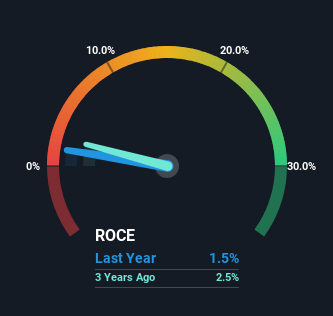- United States
- /
- Renewable Energy
- /
- NYSE:CWEN.A
Returns On Capital Signal Tricky Times Ahead For Clearway Energy (NYSE:CWEN.A)
If we want to find a stock that could multiply over the long term, what are the underlying trends we should look for? One common approach is to try and find a company with returns on capital employed (ROCE) that are increasing, in conjunction with a growing amount of capital employed. Put simply, these types of businesses are compounding machines, meaning they are continually reinvesting their earnings at ever-higher rates of return. However, after investigating Clearway Energy (NYSE:CWEN.A), we don't think it's current trends fit the mold of a multi-bagger.
We've discovered 3 warning signs about Clearway Energy. View them for free.Understanding Return On Capital Employed (ROCE)
Just to clarify if you're unsure, ROCE is a metric for evaluating how much pre-tax income (in percentage terms) a company earns on the capital invested in its business. The formula for this calculation on Clearway Energy is:
Return on Capital Employed = Earnings Before Interest and Tax (EBIT) ÷ (Total Assets - Current Liabilities)
0.015 = US$204m ÷ (US$14b - US$718m) (Based on the trailing twelve months to December 2024).
Thus, Clearway Energy has an ROCE of 1.5%. Ultimately, that's a low return and it under-performs the Renewable Energy industry average of 4.2%.
See our latest analysis for Clearway Energy

Above you can see how the current ROCE for Clearway Energy compares to its prior returns on capital, but there's only so much you can tell from the past. If you'd like, you can check out the forecasts from the analysts covering Clearway Energy for free.
So How Is Clearway Energy's ROCE Trending?
On the surface, the trend of ROCE at Clearway Energy doesn't inspire confidence. Over the last five years, returns on capital have decreased to 1.5% from 4.1% five years ago. On the other hand, the company has been employing more capital without a corresponding improvement in sales in the last year, which could suggest these investments are longer term plays. It's worth keeping an eye on the company's earnings from here on to see if these investments do end up contributing to the bottom line.
On a side note, Clearway Energy has done well to pay down its current liabilities to 5.0% of total assets. That could partly explain why the ROCE has dropped. Effectively this means their suppliers or short-term creditors are funding less of the business, which reduces some elements of risk. Some would claim this reduces the business' efficiency at generating ROCE since it is now funding more of the operations with its own money.
The Key Takeaway
In summary, Clearway Energy is reinvesting funds back into the business for growth but unfortunately it looks like sales haven't increased much just yet. Yet to long term shareholders the stock has gifted them an incredible 102% return in the last five years, so the market appears to be rosy about its future. However, unless these underlying trends turn more positive, we wouldn't get our hopes up too high.
If you'd like to know more about Clearway Energy, we've spotted 3 warning signs, and 1 of them makes us a bit uncomfortable.
While Clearway Energy may not currently earn the highest returns, we've compiled a list of companies that currently earn more than 25% return on equity. Check out this free list here.
New: AI Stock Screener & Alerts
Our new AI Stock Screener scans the market every day to uncover opportunities.
• Dividend Powerhouses (3%+ Yield)
• Undervalued Small Caps with Insider Buying
• High growth Tech and AI Companies
Or build your own from over 50 metrics.
Have feedback on this article? Concerned about the content? Get in touch with us directly. Alternatively, email editorial-team (at) simplywallst.com.
This article by Simply Wall St is general in nature. We provide commentary based on historical data and analyst forecasts only using an unbiased methodology and our articles are not intended to be financial advice. It does not constitute a recommendation to buy or sell any stock, and does not take account of your objectives, or your financial situation. We aim to bring you long-term focused analysis driven by fundamental data. Note that our analysis may not factor in the latest price-sensitive company announcements or qualitative material. Simply Wall St has no position in any stocks mentioned.
About NYSE:CWEN.A
Clearway Energy
Operates in the clean energy generation assets business in the United States.
Established dividend payer with proven track record.
Similar Companies
Market Insights
Community Narratives



